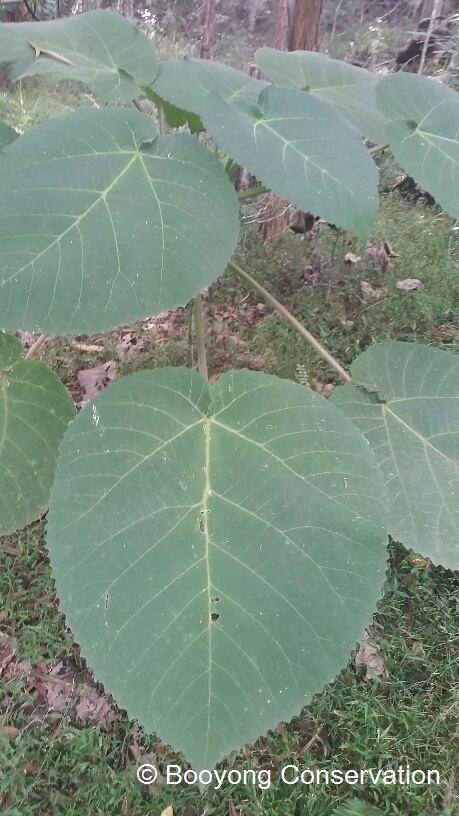 Botanical name Dendrocnide excelsa
Botanical name Dendrocnide excelsa
The Giant stinging Tree is a medium to large sized rainforest tree of eastern Australia. The leaves are large and heart shaped and alternate with toothed edges, exceeding 30 cm in width and length.
Warning – under no circumstances touch this tree. The entire tree has fine hairs which can cause severe reactions when in contact with human skin. We were alerted to the giant stinging tree when one of our friends brushed up against it and it hurt! The fine needles that cover the tree contain toxic needles which cause excruciating pain. Animals and livestock are not immune and fallen leaves can also affect you.
Stings can last from one tour two hours for minor brushes and more severe stings can last for months. The duration of the symptoms varies from person to person and varies dependent upon action taken.
I recently experienced brushing up against one of these plants and found taking an antihistamine (Phernergan 10mg) relieved the pain. We have since added this to our first aid kit, however we would recommend consulting with a medical professional for advice.
Despite the stinging nature of the tree, it still has a part to play in the ecosystems of Eastern Australian forests. They are very good fast shade trees for rainforest, not a lot of light penetrates when sun shines through two or more leaves, which you can see on the far right and bottom of the photo above. The leaves are eaten by various insects and mammals and the dark purple fruit which matures in March to August are eaten by a variety of rainforest birds including the regent bowerbird and the green catbird.
At Booyong re have recently discovered some very established Giant stinging trees on the western side of the property and you descend towards the rainforest. As you can see the canopy is significant and valuable to the ecosystem.
Whilst the flesh of the plant is edible, the stinging hairs prevent human consumption.
Ray Mears presents a you tube video on the tree https://www.youtube.com/watch?v=I6xyrYjaKDo
Treatment of the Stinging Tree
If you get stung follow this advice:
- the most important thing is that you do not rub the area, as this can break off the hairs and make them very difficult to remove
- remove visible hairs with tweezers
- apply and remove adhesive tape like duct tape, or hair-removal wax strip to the area to remove the finer hairs
- do not scratch or rub the area, this may cause the hairs to penetrate deeper into the skin.
- avoid hot temperatures. Take baths or showers in cooler water, and avoid applying anything warm to the area. Cooler temperatures are more soothing and help to reduce the redness and inflammation
 The St John Ambulance Australia have a first aid fact sheet for bites and stings
The St John Ambulance Australia have a first aid fact sheet for bites and stings
Stinging plants can cause a severe allergic reaction called Anaphylactic shock which can be fatal and includes the following symptoms
- swelling of the mouth, throat or tongue
- difficulty swallowing
- difficulty breathing or shortness of breath or wheezing
- difficulty talking
- a rash that may appear anywhere on the body
- itching – usually around your eyes, ears, lips, throat or roof of the mouth
- flushing (feeling hot and red)
- stomach cramps, feeling or being sick
- feeling weak
- collapsing or falling unconscious.
Call triple zero (000) for an ambulance. more information can be found here. If the person has a ‘personal action plan’ to manage a known severe allergy, they may need assistance to follow their plan. This may include administering adrenaline to the person via an autoinjector (such as an Epipen®) if one is available.
